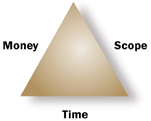It is tempting to think of project management as a modern discipline, but its major concepts have their roots in the late nineteenth century. Read this article to learn the story of how modern management theory was influenced by over a century's worth of scientific, social, and business methodologies.
In this article
Overview
Project management, in its modern form, began to take root only a few decades ago. Starting in the early 1960s, businesses and other organizations began to see the benefit of organizing work around projects. This project-centric view of the organization evolved further as organizations began to understand the critical need for their employees to communicate and collaborate while integrating their work across multiple departments and professions and, in some cases, whole industries.
Today, the basic precepts of project management are represented by the project triangle, a symbol popularized by Harold Kerzner in his landmark work, Project Management: A Systems Approach to Planning, Scheduling, and Controlling.

The early years: Late nineteenth century
We can travel back even further, to the latter half of the nineteenth century, when the business world was becoming increasingly complex, to see how project management evolved from basic management principles. Large-scale government projects were the impetus for making important decisions that became the basis for project management methodology. In the United States, for example, the first truly large government project was the transcontinental railroad, which began construction in the 1860s. Suddenly, business leaders found themselves faced with the daunting task of organizing the manual labor of thousands of workers and the processing and assembly of unprecedented quantities of raw material.
Early twentieth century
Near the turn of the century, Frederick Taylor (1856–1915) began his detailed studies of work. He applied scientific reasoning to work by showing that labor can be analyzed and improved by focusing on its elementary parts. He applied his thinking to tasks found in steel mills, such as shoveling sand and lifting and moving parts. Before then, the only way to improve productivity was to demand harder work and longer hours from workers. Taylor introduced the concept of working more efficiently, rather than working harder and longer. The inscription on Taylor's tomb in Philadelphia attests to his place in the history of management: "The father of scientific management."
Taylor's associate, Henry Gantt (1861–1919), studied in great detail the order of operations in work. His studies of management focused on navy ship construction during World War I. His Gantt Charts, complete with task bars and milestone markers, outline the sequence and duration of all tasks in a process. Gantt Chart diagrams proved to be such a powerful analytical tool for managers that they remained virtually unchanged for almost a hundred years. It wasn't until the early 1990s that Microsoft Office Project first added link lines to these task bars, depicting more precise dependencies between tasks.

Over the years, Microsoft Office Project packed even more information into the lines, such as progress lines against a baseline, variances, and lines depicting status progress at a particular point in time.
Today, Henry Gantt's legacy is remembered by a medal given out in his name by the American Society of Mechanical Engineers.
Taylor, Gantt, and others helped make project management a distinct business function that requires study and discipline. In the decades leading up to World War II, marketing approaches, industrial psychology, and human relations began to take hold as integral parts of project management.
Mid-twentieth century
During World War II, complex government and military projects and a shrinking war-time labor supply demanded new organizational structures. Complex network diagrams, called PERT charts and the critical path method were introduced, giving managers more control over massively engineered and very complex projects (such as military weapon systems with their huge variety of tasks and numerous interactions at many points in time).
Soon, these techniques spread to all kinds of industries as business leaders sought new management strategies and tools to handle their growth in a quickly changing and competitive world. In the early 1960s, businesses began to apply general system theories to business interactions. In their book, The Theory and Management of Systems, Richard Johnson, Fremont Kast, and James Rosenzweig described how a modern business is like a human organism, with a skeletal system, a muscular system, circulatory system, nervous system, and so on.
Today
This view of business as a human organism implies that for a business to survive and prosper, all its functional parts must work in concert toward specific goals, or projects. In decades since the 1960s, this approach toward project management began to take root in its modern forms. While various business models evolved during this period, they all shared a common underlying structure: a project manager manages the project, puts together a team, and ensures the integration and communication of the workflow horizontally across different departments.
Within the last ten years, project management has continued to evolve. Two significant trends are emerging:
-
Bottom-up planning This trend emphasizes simpler project designs, shorter project cycles, efficient collaboration among team members, stronger team member involvement and decision making. This trend is broadly known as agile project management, and includes a number or related methodologies, such as Scrum, Crystal, Extreme Programming, Unified Process, and many others.
-
Top-down planning and reviewing This trend is characterized by enterprise-wide decision making about the portfolio of projects that an organization should have, as well as by enabling data-mining technologies to make information in the portfolio more transparent.
Great article, Thank you for sharing this valuable info with us.
ReplyDeleteKeep updating.
Power BI Training
Power BI Online Training